Help! My succulent is dying!
Wondering how to save a dying succulent? Or are you worried that your succulent may be dying due to over- or under-watering? Find out how to tell for sure in this post!
Succulents and Sunshine is reader supported. We may earn a commission, if you purchase through links on our site, such as Mountain Crest Gardens, Amazon, or Etsy. We only promote products we use and trust.
I get quite a few emails from concerned succulent lovers, asking why their beloved plants are dying. Sometimes there's actually nothing wrong with their plants.
Other times, the problem is that the plant has been over or under watered… and it can be hard to tell which! I'm going to give you some helpful hints in this post so you can diagnose what's going wrong!
To help you even further, start by downloading my free cheat sheet to see what it looks like when your succulents need more or less water. Click here to grab that that, it'll be super helpful.
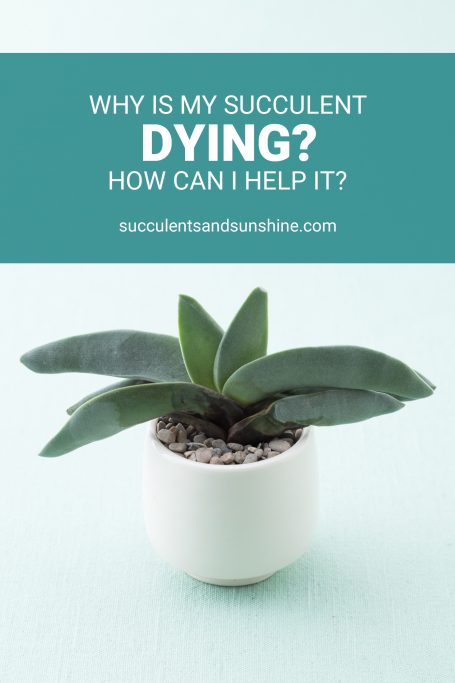
Keep track of watering…
Almost always when someone tells me their succulent is struggling I ask when they watered last.
Usually they don't know the answer!
I totally get it. Keeping track of watering can be a pain. But it will absolutely help you keep your succulents alive longer.
While you can use anything to record your watering dates (pen and paper, spreadsheet, notes on your phone) I have found that using the Succulent Tracker app (Apple | Android) has been the easiest way for me to track my group of succulents, now numbering over 300!
Inside the app you can record all kinds of things about your succulents — names, watering, repotting, treating for bugs, photos, etc.
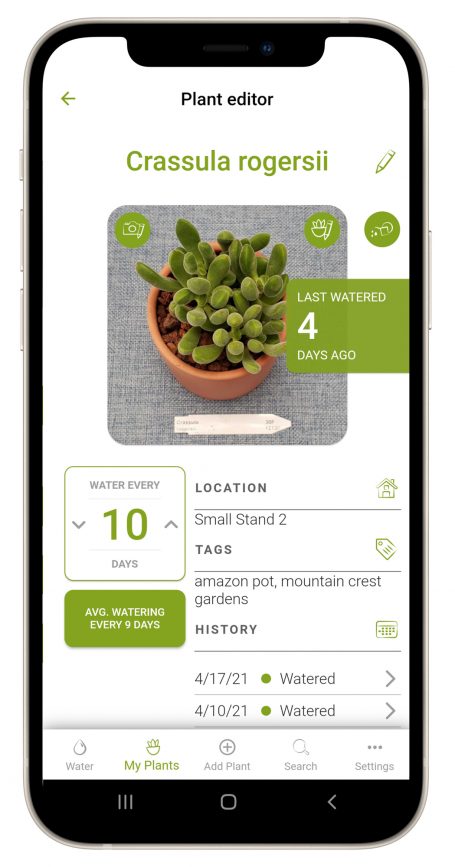
I highly recommend downloading the app (Apple | Android) and recording each time you water. And if not on the app, record it another way so you have helpful information so you can better diagnose what's happening with your succulents.
And now… let's get to the diagnosing!
Dried out, dying leaves
First of all, it's important to keep in mind that dying leaves are a natural part of every plant's life — and succulents are no exception. This doesn't always mean that your succulent is dying, or that you're doing anything wrong.
If the bottom leaves of your succulent are dried up, it is likely still healthy, but may need to be watered a tiny bit more frequently.
However, as your plant grows, it creates new leaves, while the older ones die. So, if you're seeing a few dry, crispy leaves at the bottom of the plant–and only at the bottom– there's no need to worry. This is totally normal!
On the other hand, if most of your succulents leaves are drying up, take that as a sign it wants to be watered a little more often.
If the dry leaves start to get unsightly, just gently pull them away from the base of the plant and throw them away. When you remove the leaves, keep your plant potted so you don't disturb the roots.
Only pull off the leaves that come off easily, or are totally dead. Here, I pulled the plant out of the pot to better show you what dead leaves on a healthy plant look like.
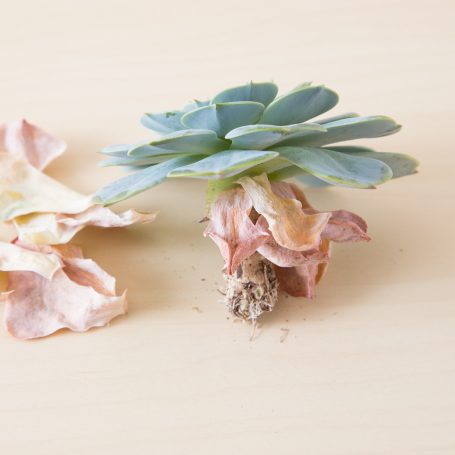
Over-watering
While dead leaves at the bottom of your succulent are perfectly healthy, dead leaves on the upper parts of new growth are a sign of a problem–usually over- or under-watering. Soil can also cause problems for succulents, as I explain in this article.
If your plant's leaves are starting to look yellow and transparent, and feel soggy or mushy to the touch, it's likely suffered from overwatering.
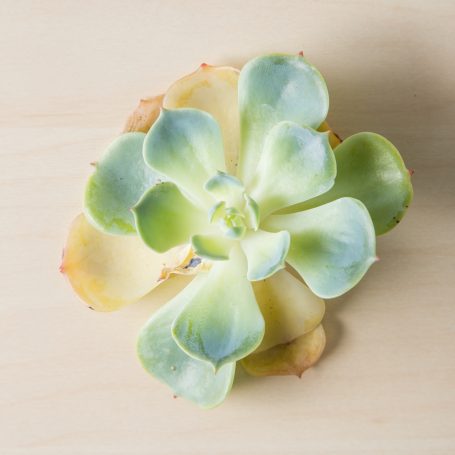
An early sign of over-watering is that leaves will start to fall off with just a slight bump. If you start to notice your succulent has a black stem or mush spots on the stem or leaves, the over-watering is getting severe, and it may be difficult to save your succulent.
Here's a Donkey's Tail succulent, in which the middle plant has been severely over-watered, and has completely rotted as a result. You can see the black stems and mushy leaves in the center.
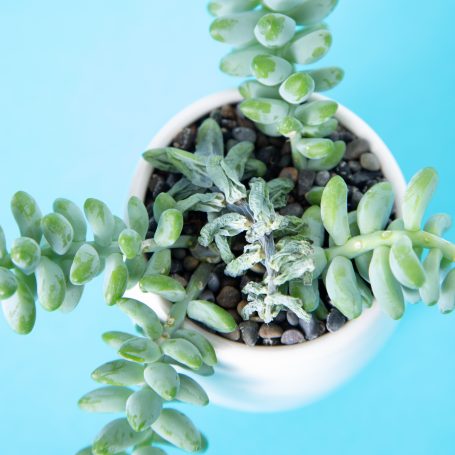
Some succulents are more sensitive to over-watering than others. Echeverias seem to be one of the most sensitive. After just two or three days with too much water, these beautiful rosettes will be on a fast track to rot.
See how I diagnose what's wrong with my succulents in this video:
How to save an over-watered succulent with a black stem
The best way to avoid over-watering is to make sure your soil is completely dried out before watering again. As I've said in a lot of my other articles, most succulents can easily go three days (and sometimes even a week or more) without water–so when it doubt, wait before watering.
As soon as you notice the symptoms of over-watering on one of your plants, start by cutting back on your watering schedule. You may also need to switch to a better soil mixture and be sure you're using a pot with a drainage hole.
If your succulent has a black stem or black spots, you'll need to do a little surgery to save your plant. This is much easier than it sounds! Just cut off the top of your plant, trim away any black spots, give the cutting three to five days to dry out, then propagate it in new soil.
On the cuttings below, you can see how I cut off every part of the stem that was soggy or blackened.
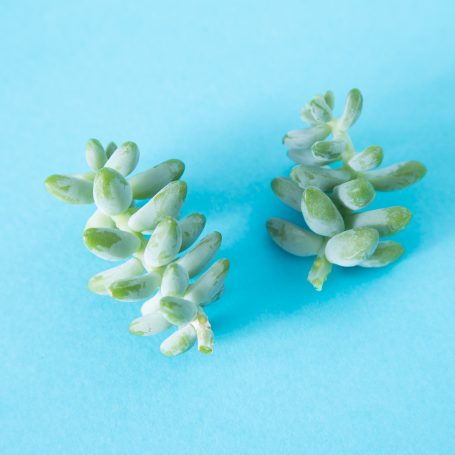
While it's unlikely that the original plant will survive, it's worth waiting to see! Leave the bottom section as-is, and don't water it until the soil is dry (all the way to the bottom of the pot). If you're lucky, a few days of drying-out time will allow the plant to recover from the over-watering, and it may start to put off new growth.
If the rotting succulent was in an arrangement with other succulents, you don't want to risk problems to the other succulents. In this case, I recommend uprooting and removing the rotting succulent.
Under-watering
While over-watering succulents is the most common problem, many succulents are also sensitive to under-watering. I've found that Portulacaria afra and Senecio haworthii like to be watered more frequently than other succulents.
If your plant's upper leaves are starting to wrinkle and get dry and crispy, then it's probably time to give your succulents a little more water. Take a look at this Mesembryanthemum lehmanni, which was actually never watered.
I planted it in this cute concrete planter, which didn't have a drainage hole, so I didn't water when I first planted it–and then completely forgot about it!
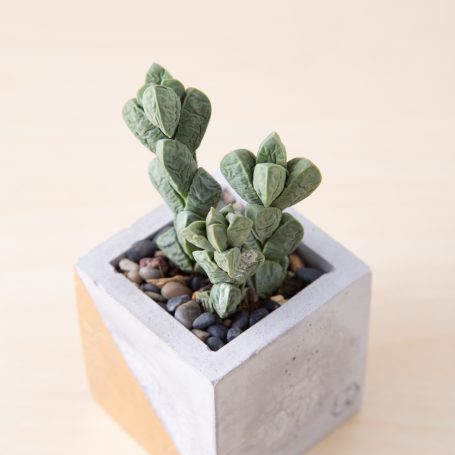
Mesembryanthemum lehmanni
With a little more frequent watering, this succulent will look good as new in a week or two.
How to save an under-watered succulent
For the most part, it's much easier to revive an under-watered succulent than an over-watered one. If yours are just starting to wrinkle, they'll probably perk up pretty quickly after one or two watering cycles. However, if they've almost completely shriveled up, I'm sorry to tell you that they're probably too far gone to recover.
To help them recover best from under watering, make sure you soak the soil really well when you water. Make sure you check out my post on how to water succulents to do this the right way.
If you're feeling adventurous, and maybe a bit desperate, you can also try water therapy. This is ONLY for under watered succulents though.
And don't forget to grab my free cheat sheet to see what it looks like when your succulents need more or less water. This way you can prevent future problems before they happen! Click here to get the cheat sheet.
I hope that by understanding these signs and symptoms of watering problems, you'll be able to save your succulent before it's too late.
Other problems
While over or under watering tends to be the most common problem new succulent growers face, there are a few more issues you may run into. These may include: stretching out, bug infestations, internal infections, and more.
I get asked this question a lot – why are the bottom leaves of my succulent dying? This video will help you understand what is normal for succulents, and what is not.
You can also look at my page with common succulent problems to continue self-diagnosing your succulent. Just make sure you get a diagnosis as soon as possible so you have a better chance of helping your succulent recover.
As you pay close attention to your succulents you'll be able to see early signs of problems which will make it much easier to save your succulent before things get too out of hand.